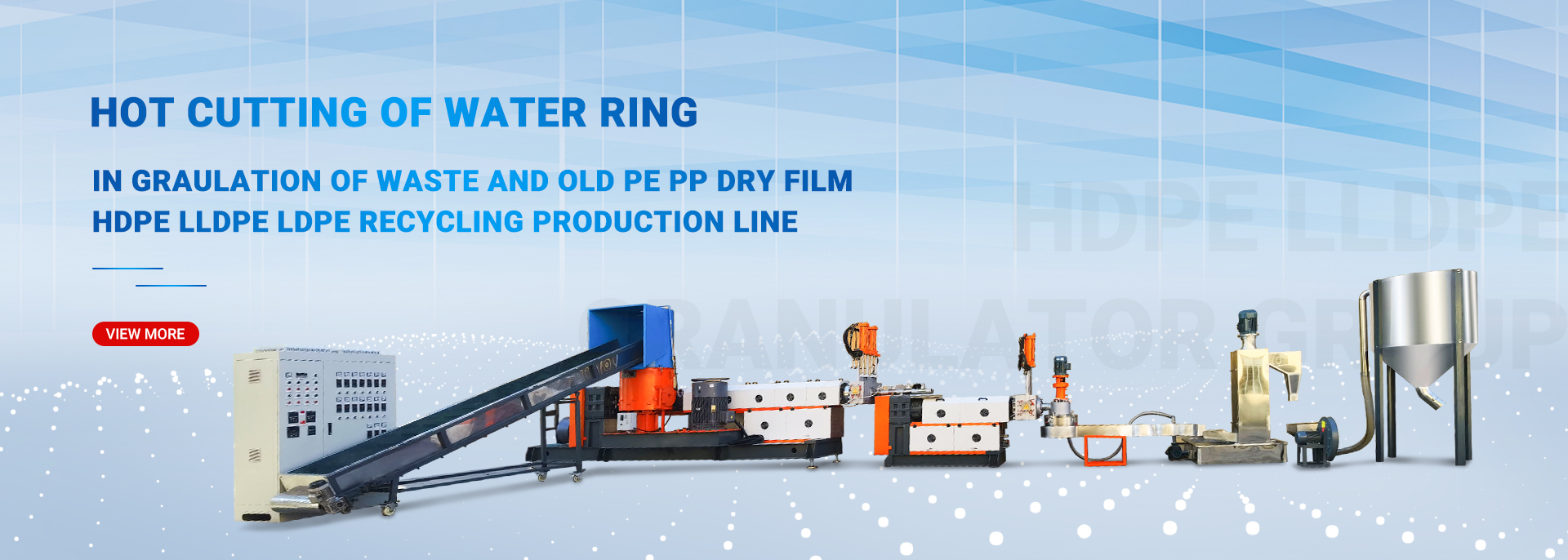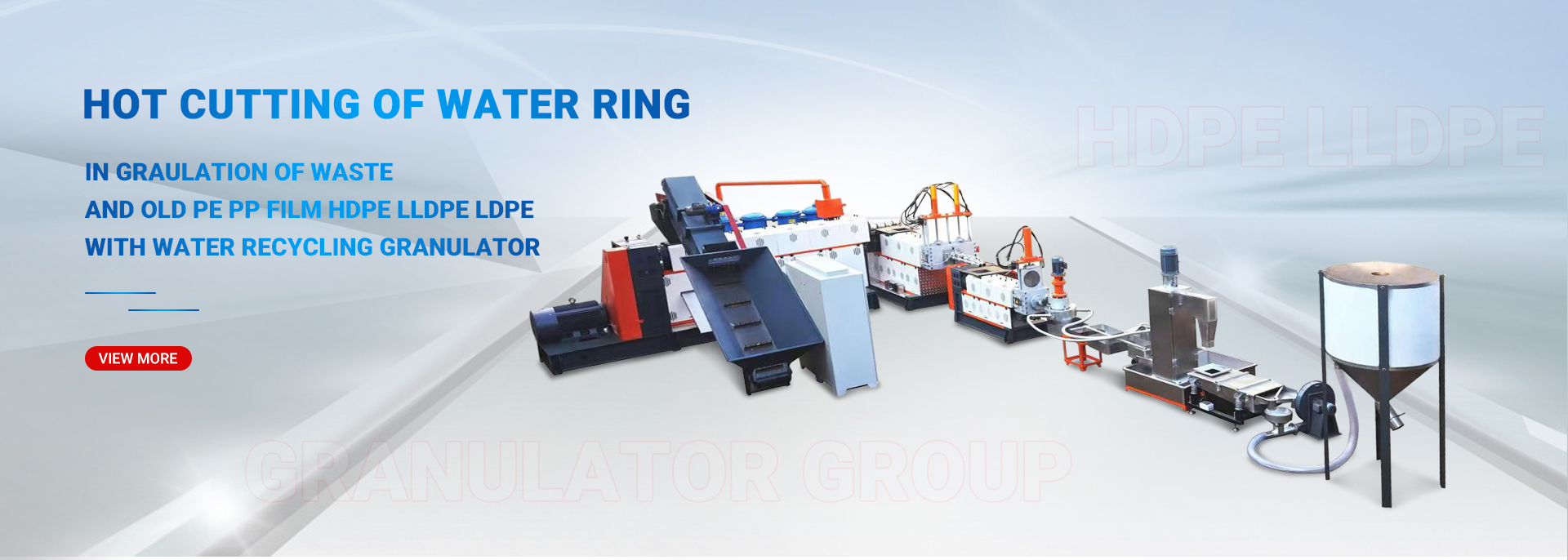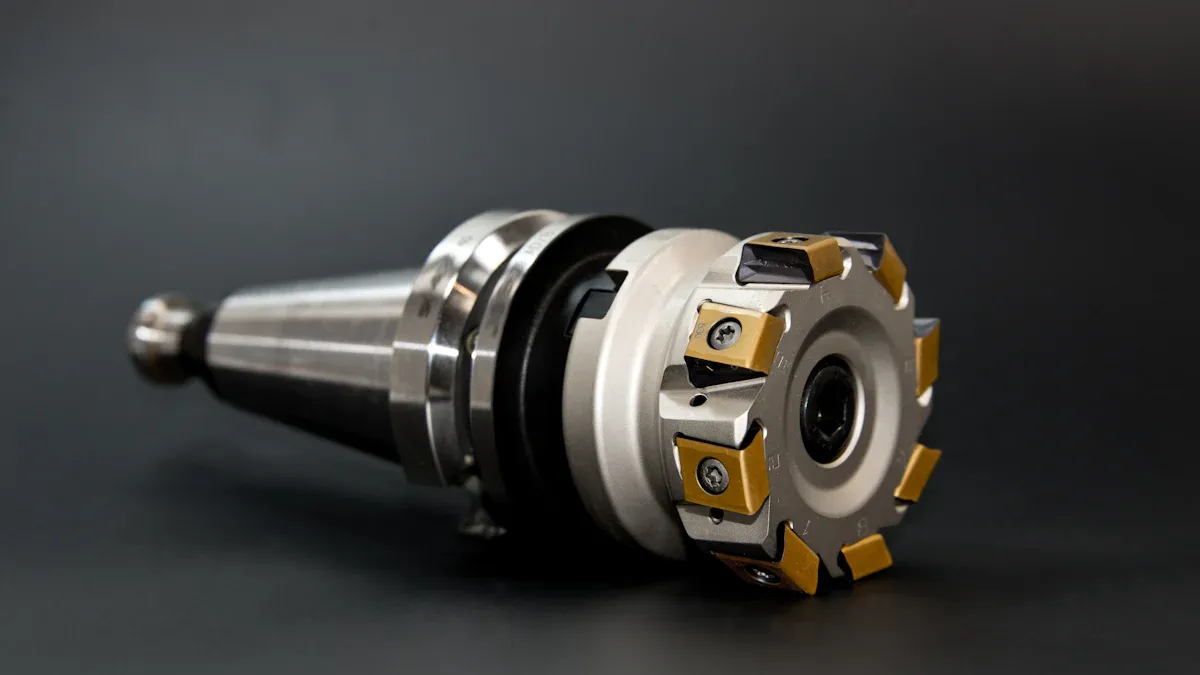
Waste reduction plays a critical role in the automotive industry, where efficient resource management directly impacts profitability and sustainability. The global automotive waste management market, valued at approximately USD 4 billion in 2023, is projected to grow to USD 7.5 billion by 2032, with a CAGR of 7.1%. A German industrial buyer recently achieved a remarkable 40% reduction in waste, setting a new benchmark for sustainability. This success was made possible through the innovative application of a pellet cutter, as detailed in this pellet cutter case study.
Key Takeaways
- A German car parts company cut waste by 40% using a pellet cutter. This shows how new technology can help the environment.
- Working with partners and giving proper training made the pellet cutter work well. This highlights how teamwork helps reach business goals.
- Watching important performance numbers (KPIs) helps find problems. Fixing these can make production better, save resources, and lower costs.
Background of the Pellet Cutter Case Study
Overview of the German auto parts supplier
The German auto parts supplier stands as a leader in the automotive industry, with a strong focus on innovation and sustainability. The company operates across multiple sectors, employing 63,762 individuals and managing 12,252 businesses. Its projected revenue for 2024 is €14.2 billion, reflecting its robust market position. Christophorus Holding GmbH, the largest company within the group, generates €757.0 million in revenue annually. Other notable contributors include LKQ Corporation and Euromaster GmbH, with revenues of €341.5 million and €160.2 million, respectively.
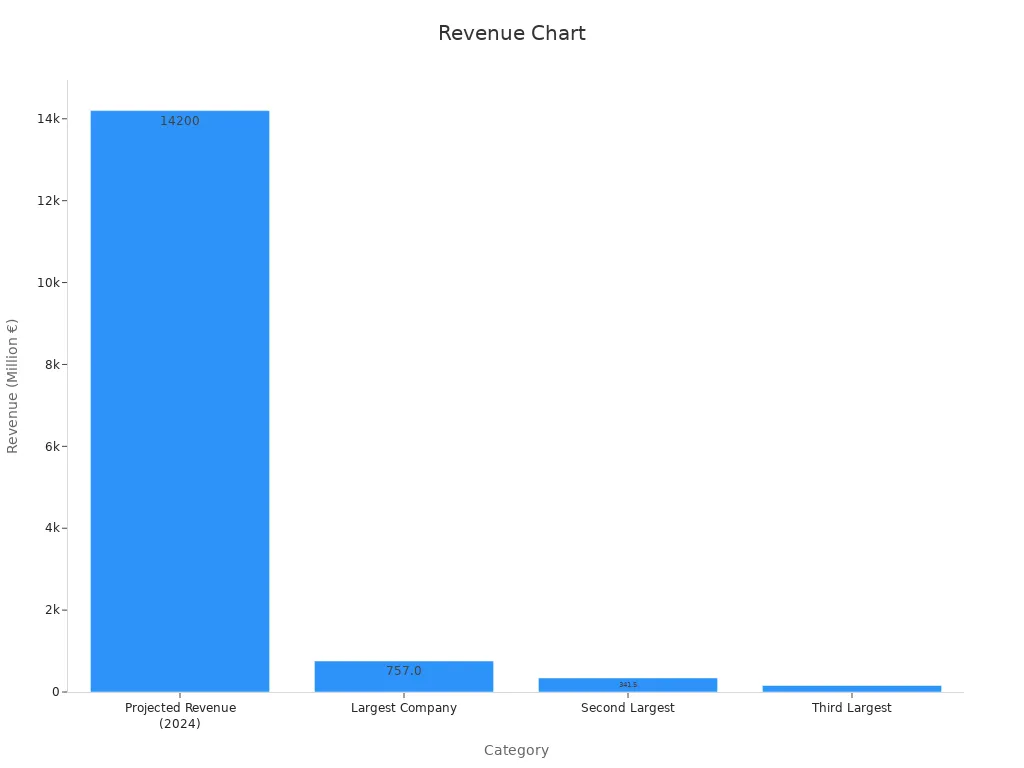
Challenges with waste management before the pellet cutter
Before implementing the pellet cutter, the supplier faced significant challenges in waste management. Inefficient material cutting processes led to excessive waste generation, increasing disposal costs and operational inefficiencies. Regulatory pressures and environmental concerns further compounded these issues, as the company sought to align with stringent European Union sustainability standards. These challenges highlighted the need for a transformative solution to optimize resource utilization and reduce waste.
Initial goals for waste reduction and sustainability
The supplier set ambitious sustainability targets to address its waste management challenges. Inspired by industry leaders like Toyota and Honda, the company aimed to achieve a 40% reduction in waste while improving recycling rates. This goal aligned with broader industry trends, where companies like GM and Toyota have achieved significant milestones, such as zero landfill status and substantial reductions in waste per vehicle. These benchmarks served as a guiding framework for the supplier’s waste reduction strategy.
| Supplier | Waste Reduction Goal | Achievements | Year |
|---|---|---|---|
| GM | 36% reduction per vehicle | 89% of waste recycled, 14 facilities with zero landfill status | Past 5 years |
| Toyota | Zero landfill status globally | 8.5kg waste per car to landfill, incinerated 560,000 tonnes of waste | Since April 2007 |
| Honda | 70% reduction target | 91% reduction in incinerated waste, 56% reduction in landfill waste | By 2010, since 2001 |
The supplier’s commitment to sustainability and operational efficiency laid the foundation for the successful implementation of the pellet cutter case study.
Identifying the Problem
Inefficiencies in material cutting processes
The German auto parts supplier faced significant inefficiencies in its material cutting processes. Traditional cutting methods often resulted in uneven cuts and excessive material loss. These inefficiencies disrupted production workflows and increased the volume of waste generated. The lack of precision in cutting also led to higher rejection rates for finished products, further compounding the waste problem. The company recognized that optimizing this process was essential to achieving its sustainability goals and improving operational efficiency.
High costs of waste disposal
The financial burden of waste disposal presented another major challenge. Disposal costs varied significantly depending on the region and method. For example:
- In San Jose, California, landfill costs reached $28 per ton, while recycling costs soared to $147 per ton.
- In Atlantic County, New Jersey, revenue from selling recyclables amounted to $2.45 million, but collection and sorting costs exceeded $3 million.
Globally, the direct cost of waste management was estimated at $252 billion in 2020. Including hidden costs, this figure rose to $361 billion. Without intervention, the annual cost of waste management could escalate to $640.3 billion by 2050. These rising costs underscored the urgent need for a cost-effective solution, such as the one highlighted in this pellet cutter case study.
Environmental and regulatory pressures
Environmental and regulatory pressures further intensified the need for change. The European Union’s stringent sustainability standards required companies to minimize waste and adopt eco-friendly practices. Municipal solid waste generation, projected to increase from 2.1 billion tonnes in 2023 to 3.8 billion tonnes by 2050, added to the urgency. The supplier faced mounting pressure to align with these regulations while maintaining its competitive edge. Addressing these challenges became a critical step in the company’s journey toward sustainability.
The Pellet Cutter Solution

Key features of the pellet cutter
The pellet cutter introduced a range of advanced features that addressed the supplier’s waste management challenges. Its underwater cutting mechanism minimized surface tension, ensuring uniform, spherical pellets. The Navigator® control system provided real-time data on extruder pressures, speeds, and temperatures, enabling precise adjustments during operation. Built-in alerts notified operators of water temperature changes, maintaining consistent pellet quality.
| Feature | Benefit |
|---|---|
| Underwater | Minimizes surface tension, resulting in spherical pellet shape. |
| Navigator® controls | Provides real-time data on extruder pressures, speeds, and temperatures for better control. |
| Built-in alerts and controls | Alerts operators to changes in water temperature, ensuring consistent pellet quality. |
The pellet cutter also offered flexible installation options, allowing seamless integration with drying and treatment equipment. These features collectively enhanced efficiency and reduced material waste.
Why the pellet cutter was chosen
The supplier selected the pellet cutter after a thorough evaluation of alternatives. Compared to competitors like Wedge Lock and Gala, the pellet cutter excelled in consistent pellet size, material compatibility, and cost-effectiveness. Its ability to handle a wide range of thermoplastics made it a versatile choice for the supplier’s diverse production needs.

The cutter’s moderate initial cost and low maintenance requirements further solidified its position as the most practical solution. This decision played a pivotal role in the success of the pellet cutter case study.
Role of partnerships in implementing the solution
Strategic partnerships were instrumental in the successful implementation of the pellet cutter. Yuyao Taipeng Machinery Co., Ltd., the manufacturer, collaborated closely with the supplier to ensure seamless integration. The partnership included tailored training programs for the supplier’s team, equipping them with the skills needed to operate and maintain the cutter effectively. Regular consultations and technical support ensured the solution met the supplier’s operational and sustainability goals.
By fostering a collaborative approach, the supplier and Yuyao Taipeng Machinery Co., Ltd. achieved a transformative outcome, setting a benchmark for waste reduction in the automotive industry.
Implementation Process
Step-by-step integration of the pellet cutter
The integration of the pellet cutter followed a systematic approach to ensure seamless operation. The process began with attaching the remote alignment adjustment device to the drive shaft. This allowed the distance measurement probe to contact the first section of the die plate and collect data. The measuring data was then transmitted to a processing device for analysis. The drive shaft was rotated to the second section of the die plate, where the probe repeated the measurement process. After transmitting the second set of data, the alignment of the cutter plate and die plate was adjusted accordingly. Finally, the remote alignment adjustment device was removed, completing the setup.
During production, the process involved melting polyethylene in an extruder, pushing it through a die plate, and cutting the strands into pellets using the cutter plate. Maintenance steps included stopping the machine, removing water from the chamber, aligning the cutter plate, refilling the chamber, and resuming pelletizing. This structured approach ensured precision and efficiency throughout the integration process.
Overcoming challenges during implementation
The implementation phase presented several challenges that required innovative solutions. Accessing relevant data proved difficult, as much of it was stored offline or in isolated systems. Centralizing data for analytics and visualization became a priority to streamline operations. The supplier also faced the challenge of fostering a dynamic culture ready to embrace change. This required revising workflows and adopting new data analytics tools to fully leverage the pellet cutter’s capabilities.
Additionally, ensuring consistent pellet quality demanded precise monitoring of extruder pressures, speeds, and temperatures. The supplier overcame these challenges by utilizing the pellet cutter’s advanced control systems and collaborating closely with Yuyao Taipeng Machinery Co., Ltd. This partnership provided the technical expertise needed to address these obstacles effectively.
Training and support provided to the supplier’s team
Comprehensive training and support played a crucial role in the successful implementation of the pellet cutter. The supplier’s team participated in mandatory training sessions to align their skills with operational requirements. Optional courses focused on sustainability and environmental standards, while certification programs provided updates on the latest research and best practices. These courses were offered twice a year to ensure continuous learning.
| Training Type | Description |
|---|---|
| Mandatory Training | Required for purchasing staff to align with their needs and understand due diligence in the supply chain. |
| Optional Courses | Available for suppliers focusing on sustainability and environmental standards. |
| Certification Courses | Offered twice a year to communicate the latest research and empower suppliers. |
| Industry-wide Training Initiatives | Provided through initiatives like the RBA to enhance supplier effectiveness. |
| Follow-up Support | Available to assist suppliers in implementing their sustainability measures. |
| Risk Assessments | Conducted annually to evaluate sustainability risks in the supplier network. |
Follow-up support and risk assessments ensured the supplier’s team could maintain operational efficiency and sustainability goals. This robust training framework contributed significantly to the success of the pellet cutter case study.
Results and Impact of the Pellet Cutter
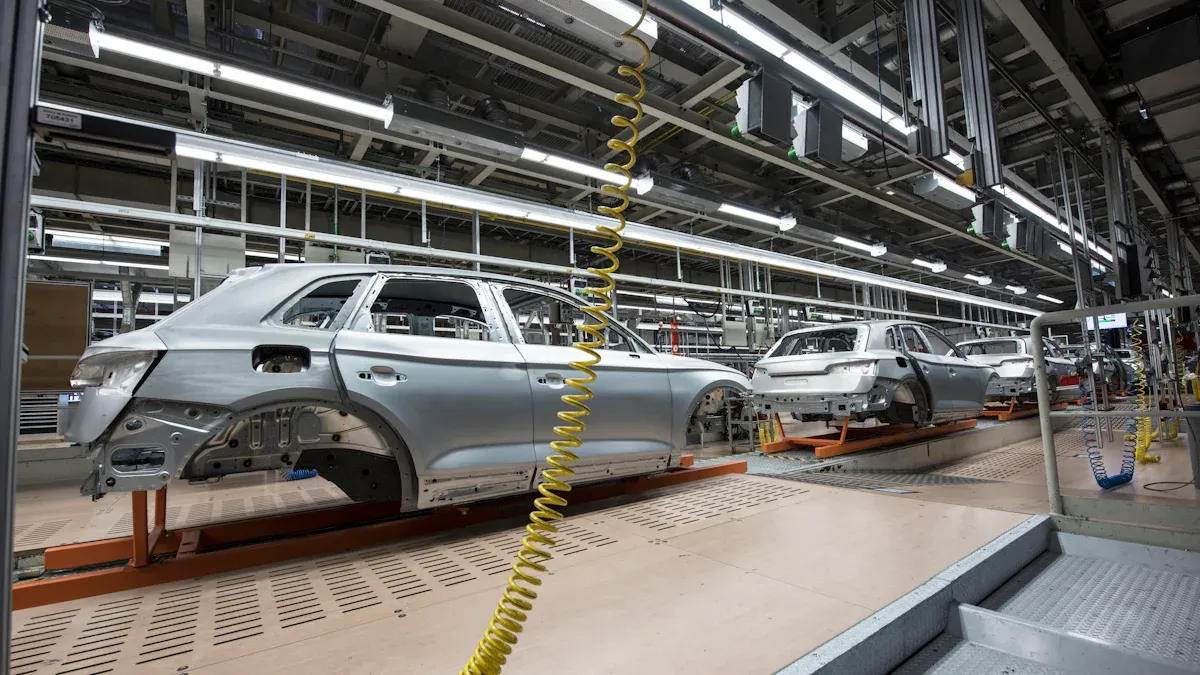
Achieving the 40% waste reduction
The pellet cutter case study demonstrated remarkable success in achieving the supplier’s ambitious waste reduction target. By integrating the pellet cutter into their production line, the company reduced material waste by 40%, surpassing industry benchmarks. This achievement was supported by improved pellet durability and reduced fines.
| Metric | Before Aid | After Aid |
|---|---|---|
| Pellet Durability (90.0) | 90.0 | 92.5-95.0 |
| Pellet Durability (80.0) | 80.0 | 85.0-90.0 |
| Fines Reduction (%) | N/A | 25-50% |
| Amperage Reduction (%) | N/A | 20% |
| Production Rate Increase (%) | N/A | 25% |
These improvements not only minimized waste but also enhanced the overall quality of the pellets, ensuring better resource utilization and operational efficiency.
Cost savings and operational efficiency improvements
The implementation of the pellet cutter resulted in significant cost savings and operational enhancements. The supplier experienced a 25% increase in production rates, reducing downtime and optimizing resource allocation. Drawing parallels to similar case studies, such as Care New England, which achieved $75 million in annual financial benefits, the supplier also realized substantial savings. These included reduced labor costs, improved material usage, and lower waste disposal expenses. The pellet cutter’s advanced features, such as real-time monitoring and precise adjustments, played a pivotal role in streamlining operations and cutting costs.
Environmental benefits and alignment with sustainability goals
The pellet cutter case study underscored the supplier’s commitment to sustainability. By reducing waste and improving recycling rates, the company aligned with global environmental standards. Efficient management of non-hazardous waste, such as plastics and metals, maximized resource recovery. Additionally, innovations in sorting technologies enhanced recycling quality, further supporting sustainability objectives.
- Kia reduced water consumption to minimize emissions.
- Volkswagen increased recycled waste to 84% through staff training.
- Ford saved over £3 million by cutting waste and energy use.
These efforts highlight the broader environmental impact of adopting advanced technologies like the pellet cutter, setting a benchmark for sustainability in the automotive industry.
Lessons Learned from the Pellet Cutter Case Study
Key takeaways for other manufacturers
The pellet cutter case study highlights several critical insights for manufacturers aiming to enhance sustainability and efficiency. Key performance indicators (KPIs) such as Overall Equipment Effectiveness (OEE), lead time, and quality defect rate serve as benchmarks for evaluating operational success. Other metrics, including labor productivity rate, capacity utilization, and first pass yield, emphasize the importance of streamlined processes. Manufacturers should also focus on reducing setup time and improving material flow to optimize production.
Tip: Monitoring KPIs like inventory turnover ratio and downtime can help identify bottlenecks and improve throughput time.
By prioritizing these metrics, manufacturers can achieve measurable improvements in waste reduction and operational efficiency.
Best practices for adopting innovative solutions
Adopting innovative solutions requires a structured approach. The pellet cutter case study demonstrates the value of proactive data selection and connecting disparate data sources. Installing instrumentation to gather relevant data ensures informed decision-making. Advanced analytics tools simplify the process of identifying inefficiencies and optimizing workflows.
| Aspect of PAT Methodology | Description |
|---|---|
| Proactive data type selection | Installing instrumentation to deliver the required data |
| Advanced analytics | Using user-friendly tools for calculations and immediate application |
| Workflow documentation | Capturing critical steps through journaling and annotation |
| Knowledge management | Communicating results via dashboards and reports |
These practices enable manufacturers to integrate new technologies effectively while minimizing disruptions.
Importance of advanced technologies in driving sustainability
Advanced technologies play a pivotal role in achieving sustainability goals. Data-driven approaches allow businesses to reduce greenhouse gas emissions and optimize supply chains. Automation in data collection and analysis facilitates real-time decision-making, ensuring efficient resource utilization. Technologies like generative AI further enhance sustainability by identifying opportunities to minimize waste and improve energy efficiency.
Note: Companies leveraging advanced technologies can align with global sustainability standards while maintaining a competitive edge.
The pellet cutter case study exemplifies how innovation can drive both environmental and operational benefits, setting a precedent for the industry.
The German auto parts supplier’s 40% waste reduction exemplifies the transformative impact of advanced technologies like the pellet cutter. This achievement aligns with broader industry trends, as seen in manufacturers like GM, Toyota, and Honda.
| Manufacturer | Waste Reduction Achievements | Additional Notes |
|---|---|---|
| GM | 36% reduction per vehicle; 89% of waste recycled; 14 facilities with zero landfill status | Energy generated from waste materials |
| Toyota | Achieved zero landfill globally in 2007; Previously sent 8.5kg of waste per car to landfill | Incinerated 560,000 tonnes of waste in 2006 |
| Honda | Zero landfill at four Japanese plants since 2000; 56% reduction in North America (2001-2007) | 91% reduction in incinerated waste since 1999 |
| Kia | Environmentally friendly plant in Slovakia; ISO 14001 certification | Leading example of balancing manufacturing and environmental responsibility |
Adopting innovative solutions remains essential for achieving sustainability goals and maintaining competitiveness in the automotive industry.
FAQ
What industries can benefit from the pellet cutter?
The pellet cutter is ideal for industries like automotive, packaging, and construction. Its versatility allows it to process various thermoplastics, enhancing efficiency and reducing waste.
How does the pellet cutter improve sustainability?
The pellet cutter minimizes material waste by ensuring precise cuts and uniform pellets. This reduces disposal needs, aligns with environmental standards, and promotes resource conservation.
Is training required to operate the pellet cutter?
Yes, training ensures operators understand the pellet cutter’s advanced features. Tailored programs cover setup, maintenance, and troubleshooting, maximizing efficiency and minimizing downtime.
Post time: Mar-28-2025

